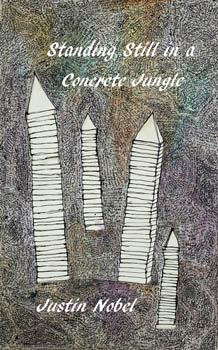The subway is an often filthy, occasionally flooded, sometimes deadly place New Yorkers love to complain about, which is why one cold, February evening I boarded an uptown 1 train and didn't get off for 14 hours. I observed the trivial details most people ignore, what sort of satchels businesspeople were carrying, what kind of socks bums were wearing. The experience was surprisingly enjoyably, and inspired an odd project. I would stand still for extended periods of time in iconic New York City spots and observe minutiae, all morning in a Chelsea elevator, all day on a Central Park bridge, all night in the ER Waiting Room. By recording the city's daily nothings I aimed to capture an invisible pulse so easily ignored. In the end I captured much more, and that blog is now a book called, Standing Still in a Concrete Jungle.

I'm not the first person to document subway life. In the early 1940s, the famous Great Depression photographer Walker Evans pointed his camera underground. With a lens hidden between the buttons of his coat, Evans spent hours photographing the New York subway's ever-shifting stream of faces. Men looked like Film Noir detectives, with brimmed hats, cheap suits and dark circles under their eyes. Women wore large feathers, fancy brooches and black veils. People were gaunter, and more serious. One similarity to today was the taboo of interaction. Most of Evan's subjects are blankly examining ads or staring into space. In 1974, the psychologist Stanley Milgram attempted to quantify New York subway riders' indifference with a survey that asked people to give up their seats. Surprisingly, more than two-thirds did. The hard part was asking. "The words seemed lodged in my trachea and would simply not emerge," said Milgram.
All New Yorkers understand the invisible barrier that keeps us from talking to one another on the subway, but there's an equally strong force that attracts us to complete strangers. Who doesn't fantasize about finding that lost subway love who smiled coquettishly one morning on the F train. There is something special about being whirred through the earth in a dark tube, trapped in a capsule zooming blindly beneath the city, the possibility of randomly seeing a friend you haven't seen in years, or your roommate.
The night I spent in the subway I saw white graffiti artists pick a fight with black basketball players, wealthy uptown women scoff at a bum, a pair of teenagers rant about their sexual escapades. Most memorably, I saw the city's invisible change from light to dark and back again to light. Theater goers became club kids became ghostly creatures of the 3 a.m. night became dish washers and painters headed downtown for work became bankers and secretaries doing the same. Sure, it's nothing more than the daily New York stampede, but it's exactly that monotony that makes it amazing.
During hour 13 of my subway observation, utterly exhausted and worn ragged, I looked outside at 225th Street in the Bronx, where the train runs briefly above ground, and noticed the pitch black night sky had become fuzzy and purple. The city is tiring and tragic and relentless, but it's also impossibly beautiful. You just must take the time to stand still and observe it.